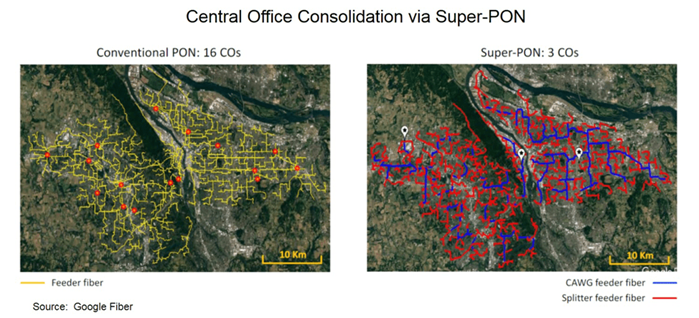I first came across the reference to Super-PON back in 1996 at an IEEE Communications Society Conference. At that time, Super-PON was described as supporting a split ratio of 1:1024 at a range of 100km. The overall network capacity of the Super-PON was 2.5Gbit/s TDM downstream and 300Mbit/s ATM-based TDMA upstream and it introduced the concept of optical amplifiers along the fiber paths. At the time this was particularly forward thinking, as the only PON systems that had been deployed were BPON systems supporting a split ratio of 32 subscribers and a capacity of 622Mbit/s / 155Mbit/s. For reference, GPON can support a split ratio up to 1:64 at a range of 20km with a network capacity of 2.5Gbit/s / 2.5Gbit/s.
A new version of the Super-PON describes a system that can support up to 1024 subscribers at 50km via a TWDM PON, but also allow 10Gbit/s, 40Gbit/s or 100Gbit/s point-to-point business connections to be added to the same pair of fibers. Residential subscriber bandwidth of up to 10Gbit/s is supported.
So, while the concept of a Super-PON is not necessarily new news, the fact that it is Google Fiber that has been actively promoting it and pushing for a standard is.
The question is why?
Google abruptly stopped deployment of its FTTH gigabit network to any new cities back in 2016 – around the same time it acquired Webpass, a fixed wireless access provider. According to Google, their venture into building access network infrastructure taught them a number of lessons, including the fact that building network infrastructure, particularly in the access network, is complex (GASP!); and that the last mile construction represents the bulk of spending mostly due to labor (double GASP!).
But that is a story for another blog entirely. Let’s get back to the Super-PON.
Originally titled “GO-LONG”, Google Fiber has been talking about the Super-PON concept at a number of industry event over the past 18 months.
The key underlying technologies for Super-PON are DWDM and amplification. By implementing a DWDM system, multiple channels may be multiplexed over a single feeder fiber, allowing support for more customers with less fiber. The system separates the channels with a passive wavelength router in the outside plant. The Super-PON will use amplification in both the downstream and upstream – allowing the system to achieve the longer reach. In the Super-PON, the amplification elements reside in the central office (CO) allowing the outside plant to retain the passive nature of conventional PONs.
Unlike NG-PON2, the ONT optical transceivers don’t need tenability – although that is an option. Because of the filtering inherent in the network, the transceivers only need tunable lasers, making them less expensive and complex than NG-PON2 transceivers that also require tunable receivers.
CO consolidation and reduced fiber requirements
The attractiveness of the Super- PON is really driven by increasing the number of subscribers in order to reduce the cost of the network. According to Google Fiber, the Super-PON would enable a more simplified access network infrastructure that would require significantly fewer COs and smaller fiber bundles (12-48 fiber cables vs. 432 fiber cables). This architecture would allow for better fiber utilization and lower OSP building costs.
From a CO consolidation perspective, Google Fiber provided an example of a real- world application based on a medium-sized US metropolitan area. In this example, they were able to reduce the number of COs from 16 to three using the Super-PON concept.

CO consolidation would also result in fewer fibers and smaller cables needed to support the same number of customers. An example cited by Google Fiber was the ability to go from 432-fiber cables to 12-48-fiber cables. This offers multiple advantages, such as the ability to use micro-trenching and directional boring techniques as well as significantly shorter repair times.
According to Google Fiber, a traditional 432-fiber cable (36 ribbons of 12 fibers) takes an average of six hours (at 10 min per ribbon) plus an additional two hours for cable manipulation, resulting in an average time to repair a cable damage of eight hours.
Whereas, for a 24-fiber cable, the time required to splice the broken cable is significantly shorter (40 minutes). Adding an additional hour for cable manipulation, the average time to repair a damaged cable is now less than two hours.
Standards status
In July 2018, the IEEE 802.3 Working Group approved the formation of a Super-PON Study Group to investigate EPON specifications based on Google Fiber’s Super-PON technology. In addition, the concept has been presented to both the ITU-T SG15, as well as FSAN to investigate this specification as an NG-PON2 extension. Super-PON will operate in a difference region of the spectrum with respect to existing EPON systems and introduces a number of new technologies, including DWDM, amplification, mux/demux (e.g., EDFAs and CAWG).
Final thoughts
The concept of the Super-PON is definitely intriguing, as operators are always looking for ways to simplify their network architectures and reduce costs. And the fact that it supports both point-to-multipoint and point-to-point architectures does lend itself additional value. But that capability is already available with NG-PON2 systems and demand for that capability remains nascent due to the current costs of components. While the race to 5G will certainly be the catalyst for additional fiber deployments, the question is whether this Super-PON (my preference would be to call it an XL-PON) is really necessary when next-generation fiber access solutions have already been standardized.
But as they say in sports, go big or go home, and I guess that is what Google Fiber intends to do.
